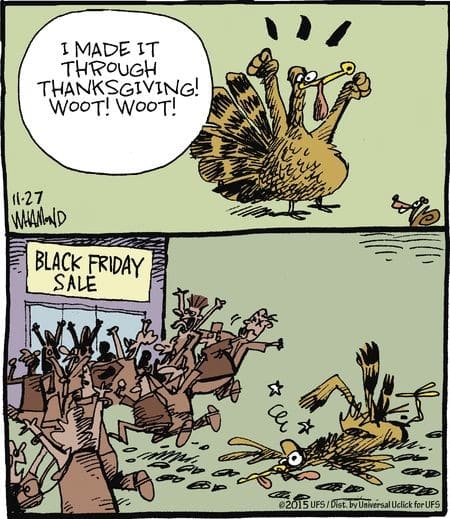By James F. Saunders, Esq.
Yes, what used to be the tradition of shopping at the crack of dawn on the Friday after Thanksgiving has given way to downing your Thanksgiving feast and rushing out to get a jump on Holiday Shopping. Many retailers are now kicking off the Holiday Shopping season with huge discounts on Thursday afternoon/evening.
Black Thursday is around the corner. Retailers need to be prepared for the increased risks associated with combining exceptionally low prices on limited items with a crowd of consumers who have been standing in line for hours chomping at the bit to get the best deal.
While ideally getting great deals should be a fun exercise for consumers, this is not always the case. Every apple tree has at least a few bad ones, and the same goes for crowds.
Real life examples of things going wrong are plentiful:
- That’s my Xbox, back-off or else – A 32-year-old southern California woman broke out pepper spray, which she then used to douse her fellow shoppers so she could grab a discounted Xbox.
- In the “this was a bad idea” category – A shopping center in Torrance, California made the regrettable choice of dropping gift certificates from the ceiling. At least 10 people were injured in the ensuing free-for-all.
- Gun fight at a toy store – Two women were fist fighting over who knows what (perhaps the last available hot-selling action figure) when the two men accompanying them pulled out their guns and shot each other.
- True tragedy – Jdimytai Damour (“Jimbo” to his friends) was just 34 years old in 2008 when, while working for Walmart on Black Friday, a crowd of deal-seekers rushed through the doors that Jimbo was guarding and trampled him to death.
The examples of injury incidents are too numerous to list. But certainly the normally-inherent retail shopping safety risks (such as slip/trip and falls, cluttered walkways, items falling from shelves, assaults, crowded parking lots and car accidents) are heightened when there is an excessive amount of highly-emotional, and often short-fused people, competing for the same prize.
Preparation is the key to avoiding injuries and problems.
What does the law say about civil injury claims?
Having people get injured in your establishment is not just a bad thing in and of itself, it also sets you up for civil injury claims.
What does it take for a plaintiff to establish a civil injury claim in California? They must prove that: (1) The retailer was negligent in the use or maintenance of the property; (2) the plaintiff was harmed; and (3) the retailer’s negligence was a substantial factor in causing the plaintiff’s harm. [Rowland v. Christian (1968) 69 Cal.2d 108]
California retailers therefore have a duty to use reasonable care to discover any unsafe conditions at their property and to repair, replace or give adequate warning of anything that could be reasonably expected to harm others. [Williams v. Carl Karcher Enters., Inc. (1986) 182 Cal.App.3d 479, 488] A retailer must also use reasonable care to protect its patrons from another person’s harmful conduct on its property, if it can reasonably anticipate such conduct. [Taylor v.Centennial Bowl, Inc. (1966) 65 Cal.2d 114, 121]
Certainly when a retailer anticipates a large crowd at a sales event, there are enhanced safety concerns that must be reasonably addressed.
What guidance has OSHA provided to help retailers prepare for holiday crowds?
Following the tragic death of Jdimytai Damour (referenced above), OSHA prepared guidelines to help employers and store owners avoid injuries during the Holiday Season. The guidelines are broken down into four categories:
Planning:
- Where large crowds are expected, hire additional staff as needed and have trained security or crowd management personnel or police officers on site.
- Create a detailed staffing plan that designates a location for each worker. Based on the size of the crowd expected, determine how many workers are needed in various locations to ensure event safety (e.g., near the entrances and throughout the store).
- Contact local fire and police agencies to determine if the event site meets all public safety requirements, and ensure that all permits and licenses are obtained and that local emergency services are aware of the event.
- Designate a worker to contact local emergency responders if necessary.
- Designate a store manager to make key decisions as needed during the event.
- Provide legible and visible signs that describe entrance and exit locations, store opening times, and other important information such as the location of major sale items and restrooms. Create pamphlets with this information, too.
- Prepare an emergency plan that addresses potential dangers facing workers, including overcrowding, crowd crushing, being struck by the crowd, violent acts and fire. Share this emergency plan with all local public safety agencies.
- Train workers in crowd management procedures and the emergency plan. Have a practice session.
Pre-Event Setup:
- Locate sale items in different parts of the store to prevent overcrowding in one place.
- Locate shopping carts and other potential obstacles or projectiles inside the store and away from the entrance, not in the parking lot.
- Make sure that outside personnel have some way to communicate with personnel inside the store and emergency responders.
- Provide crowd and entry management measures at all entrances, including the ones not being used. If possible, use more than one entrance.
- Set up barricades or rope lines for crowd management well before customers arrive. Set these up so that the customers’ line does not start right at the store entrance. Include an adequate number of breaks and turns at regular intervals to reduce the risk of customers pushing from the rear and possibly crushing others.
- Designate workers to explain approach and entrance procedures to the arriving public, and direct them to lines or entrances.
- Consider using an online lottery for “hot” items and/or mechanisms such as numbered wristbands or tickets to provide the earlier-arriving customers with first access to sale items.
- If appropriate, provide public amenities including toilets, washbasins, water and shelter.
- Keep customers waiting in line informed. Distribute the informational pamphlets that you prepared in advance.
- Shortly before opening, remind waiting crowds of the entrance process. Make sure all employees and crowd control personnel are aware that the doors are about to open.
During the Sales Event:
- Use a public address system or bullhorns to manage the entering crowd and to communicate information or problems.
- Provide a separate store entrance for staff. Provide door monitors there to prevent crowd entry.
- Provide a safe entrance for people with disabilities.
- Staff entrances with uniformed guards, police or other authorized personnel. Position them to the sides of entering (or exiting) public, not in the center of their path.
- When the store reaches maximum occupancy, do not allow additional customers to enter until the occupancy level drops.
Emergency Situations:
- Do not restrict egress, and do not block or lock exit doors.
- Know in advance who to call for emergency medical response.
- Keep first-aid kits and Automated External Defibrillators (AEDs) available, and have personnel trained in using AEDs and CPR onsite.
- Instruct employees that in the event of an emergency they must follow instructions from authorized first responders, regardless of company rules.
Certainly adherence to the guidelines offers no guarantees; however, when assessing the standard of reasonableness, such adherence will go a long way in establishing that the standard was met.
Happy Thanksgiving, and cheers to a safe and profitable Holiday Season!

Mr. Saunders earned his B.A. in Political Science from California State Polytechnic University, Pomona, CA and his Juris Doctorate at the California Western School of Law, San Diego, CA. He is admitted to practice in all courts in the State of California as well as the Unites States District Court for the Southern District of California. His hobbies include basketball, hiking and bodyboarding.

